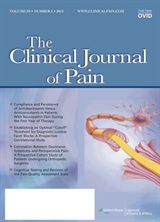Continuing Medical Education
You’re eligible to earn 0.5 CME credits for reading this report.
Generating CME Eligible Questions

Intranasal Tapentadol vs Intravenous Paracetamol for pain in Lower Limb Orthopaedic Surgeries

Intranasal Tapentadol vs Intravenous Paracetamol for pain in Lower Limb Orthopaedic Surgeries
Intranasal Tapentadol Versus Intravenous Paracetamol for Postoperative Analgesia in Lower Limb Orthopaedic Surgeries Under Spinal Anaesthesia: A Single Blind RCT.
Clin J Pain . 2024 Aug 1;40(8):463-468.Did you know you're eligible to earn 0.5 CME credits for reading this report? Click Here
Synopsis
Seventy-four patients undergoing lower limb orthopedic surgeries under spinal anesthesia were randomized to receive either intranasal tapentadol (44.5 mg, n=37) or intravenous paracetamol (1 g, n=37) every 6 hours for 72 hours, starting 3 hours after surgery. The primary outcome was pain intensity measured by the Visual Analog Scale (VAS). Secondary outcomes included systolic blood pressure (SBP), diastolic blood pressure (DBP), heart rate (HR), and the need for rescue analgesia. Outcomes were assessed at multiple time points up to 72 hours post-intervention. Overall, the study revealed that intranasal tapentadol resulted in significantly lower pain scores compared to intravenous paracetamol. Additionally, patients in the tapentadol group required no rescue analgesia and exhibited favorable hemodynamic parameters.
Publication Funding Details
Why was this study needed now?
Postoperative pain management remains critical in lower limb orthopedic surgeries. Intranasal tapentadol, a novel centrally acting analgesic with dual mechanisms, offers ease of administration and a favorable safety profile compared to intravenous paracetamol, a commonly used analgesic with predictable pharmacokinetics but requiring complex administration. Despite their individual benefits, no direct comparison of these two agents had been made for postoperative pain relief. This study addresses a significant knowledge gap and seeks to determine the superiority of one approach over the other.
What was the principal research question?
In patients undergoing lower limb orthopedic surgeries under spinal anesthesia, does intranasal tapentadol result in better postoperative analgesia compared to intravenous paracetamol over a 72-hour period?
What were the important study characteristics?
74
Total Sample Size
37
Tapentadol
37
Paracetamol
Anaesthesia
Lower = Better
Pain
Lower = Better
Scale: 0.0 to 10.0 cm
Vitals
Lower = Better
Vitals
Lower = Better
Vitals
Lower = Better
Randomized Controlled Trial
Locations: India
Blinded
Who was blinded? Outcome Assessors
Superiority
Outcomes: Pain, Vitals
Outcomes: Vitals
Outcomes: Pain
Outcomes: Vitals
Outcomes: Pain
Outcomes: Vitals
Outcomes: Pain
Outcomes: Vitals
Outcomes: Pain
Outcomes: Vitals
Outcomes: Pain
Outcomes: Vitals
Outcomes: Pain
Outcomes: Anaesthesia
What were the important findings?
Intranasal tapentadol reduced VAS pain scores more effectively than intravenous paracetamol at all measured time points except 36 hours, with the greatest reduction at 72 hours (p<0.001). A higher proportion of patients in the paracetamol group (21.6%) required rescue analgesia compared to none in the tapentadol group (p=0.003). Hemodynamic parameters (SBP and HR) were significantly lower in the tapentadol group, particularly at 24 and 72 hours (p<0.05).
What should I remember most and how will this affect the care of my patients?
Intranasal tapentadol is superior to intravenous paracetamol for postoperative pain management in lower limb orthopedic surgeries, offering better pain control and reduced need for rescue analgesia. Clinicians should consider its ease of administration and hemodynamic stability when selecting analgesics. However, the study's small sample size and limited adverse effect data are notable limitations.
DISCLAIMER:
The authors responsible for this critical appraisal and ACE Report indicate no potential conflicts of interest relating to the content in the original publication.
Did you know that you’re eligible to earn 0.5 CME credits for reading this report!
Learn about our AI Driven
High Impact Search Feature
Our AI driven High Impact metric calculates the impact an article will have by considering both the publishing journal and the content of the article itself. Built using the latest advances in natural language processing, OE High Impact predicts an article’s future number of citations better than impact factor alone.
Continue



 LOGIN
LOGIN

Join the Conversation
Please Login or Join to leave comments.